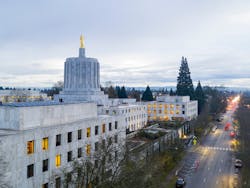In the midst of a record-breaking heat wave, wildfires and power outages, the Oregon Legislature Sunday passed a bill, HB 2021 C, that calls for 100% clean energy by 2040 as well as the inclusion of microgrids as part of community-based renewable energy projects. Oregon Governor Kate Brown is expected to sign the bill.
Temperatures hit 108 degrees on Saturday, 112 degrees on Sunday and 116 degrees on Monday in Portland. In addition, on Wednesday Brown called for a state of emergency in response to the wildfire threats across the state.
Power outages plagued utility customers of both Portland General Electric (PGE) and PacifiCorp, with more than 13,000 PGE customers affected and, at one point, 30,000 PacifiCorp customers in the dark for two hours in southern Oregon. The cause of the PacifiCorp outage is still being investigated, said company spokesman Tom Gauntt.
During heat waves, such outages can be deadly and resilience solutions are critical, said Alessandra de la Torre, energy justice organizer for Rogue Climate, a climate organization in southern Oregon.
“Thirty thousand Pacific Power [a subsidiary of PacifiCorp] customers in southern Oregon lost power right in the middle of a historic heat wave,” she said. ”Power outages or utility disconnections can quickly become deadly, with heat exhaustion turning into heat stroke. It has never been more clear: We need to make sure that nobody is disconnected from vital energy systems, especially in these climate change-fueled disasters.”
Preliminary findings indicate the outage was the result of a “bushing” failure, according to PacifiCorp’s Gauntt. That’s a hollow electrical insulator that allows an electrical conductor to pass safely through a conducting barrier such as a transformer or circuit breaker without making electrical contact.
Microgrids for communities
Microgrids are mentioned in the 100% Clean Energy for All measure’s definition of community-based renewable energy, which is required by the bill.
Community-based renewable energy is “one or more renewable energy systems that interconnect to utility distribution or transmission assets and may be combined with microgrids, storage systems or demand response measures, or energy-related infrastructure that promotes climate resiliency or other such measures,” the bill said.
These systems must have community ownership by a nonprofit, local or tribal government, or renewable energy cooperative. They also must provide an agreement that shows how the infrastructure provides direct advantages to the community where the project is sited, said Oriana Magnera, energy, climate and transportation manager for Verde, a nonprofit organization whose goal is to build environmental wealth through advocacy.
$50M to support projects
The bill provides $50 million to support these kinds of projects. “We’re expecting microgrids and islanding to be a big component of resiliency focused projects,” said Magnera. “These technologies can also be incorporated into locally negotiated utility rates, and the jurisdictions that work with utilities on that front can focus the power procured for their residents on microgrids,” she said.
The bill also calls for consultation with tribes, prioritizes benefits for rural, coastal, low-income, and black, indigenous and people of color communities and requires strong labor standards.
Microgrids are especially important when extreme weather hits and the grid fails communities, said de la Torre of Rogue Climate. “Community renewable energy projects with microgrids and energy storage can ensure that people have the energy that they need in heat waves, fires and other disasters.” During outage events, microgrids provide vital services such as heating and cooling, phone charging and medicine refrigeration, she added.
PacifiCorp has “islanding” projects but no microgrids in the works, according to Gauntt. PGE, on the other hand, is now testing numerous projects that aim to provide resilience with microgrids. For two PGE pilot partnerships, the utility owns and deploys batteries behind the meter at customer sites, and the customers provide solar and other on-site resources to create microgrids. The utility has deployed a battery at the Beaverton Public Safety Center and is planning to deploy another one at the Oregon National Guard’s Anderson Readiness Center.
To provide reliability as PacifiCorp retires coal plants and implements the 100% Clean Energy for All bill, the utility will focus on innovations in technology, said Gauntt. That includes an advanced nuclear project — a partnership with TerraPower — for the site of a retiring coal plant in Wyoming. PacifiCorp’s coal resources will be removed from Oregon rates by 2030, as required by SB 1547.
Heat cripples relief efforts
In southern Oregon — where thousands of people lost their homes to the Almeda Fire last year — the need for resilience is clear, said de la Torre. The recent heat wave forced Rogue Climate to “drastically” reduce the hours of its fire relief site that serves people displaced because of temperatures above 100 degrees. Those temperatures, she said, made it unsafe for community members, volunteers and staff to work without air conditioning.
Clean energy is affordable and can help lift communities across Oregon out of the economic downturn that has resulted from the pandemic and the destructive summer wildfires in the state, said de la Torre. “100% Clean Energy for All is a critical opportunity for Oregon to create jobs, boost local economies and ensure a just transition when we need it most,” she said.
Track news about how microgrids protect lives during disasters. Subscribe to the free Microgrid Knowledge Newsletter.








